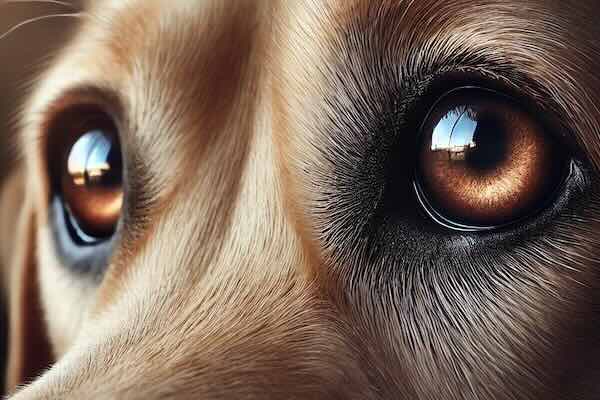Tails Are for Dogs, Eyebrows Are for Humans
January 23, 2025

Tails Are for Dogs, Eyebrows Are for Humans
We’ve all seen that exuberant tail-wag—maybe when your dog spots another pup at the park, or just when you come back from checking the mail. It’s an instantly recognizable “I’m so happy!” signal. But have you ever stopped to think about where that wagging behavior came from and who it was actually meant for in the first place?
Dogs typically dont even look at each other.
If you just watch dogs (as if you were a dog), you will see sent, posture, and movement as key drivers for the dogs. Not facial expressions. Also this is sensed from the side views not direclty look at each other. The Posture of of front paws forward and butt up = "Play". The posture of butt back to the other dogs nose, "find out if im a friend, we will exchange". This goes on to very deep dog senses created over a long long time.
An Ancient, Canine-to-Canine Signal
Before dogs hung out on couches and wore little holiday sweaters, they were wolves (or at least close relatives). Back in the wild, there was no reason to wag a tail at humans, because—simply put—humans weren’t around (or at least not in any friendly sense). The tail wag evolved as an intra-species signal within canine packs. Picture wolves roaming the tundra and needing to communicate quickly: friend or foe, submissive or dominant, playful or on guard. A flick of the tail, a certain posture, or a slow wag could convey a wealth of information to other wolves. High, rigid wag? Tension or alertness. Sweeping, helicopter-like wag? Utter excitement or invitation to play.
This built-in “semaphore system” served (and still serves) a crucial role in canine social structure. Even after domestication started, that wagging vocabulary was already well ingrained, perfectly adapted for dog-to-dog conversations.
Domestication and a New Audience
Then humans entered the scene in a big way. Over thousands of years, dogs (descended from wolves) found a niche living alongside people—hunting with us, guarding our homes, eventually sleeping at the foot of our beds. This new environment introduced an entirely different audience: us. We might understand a wagging tail at some base level (we can tell “Oh, the dog’s happy!”), but in many ways, we’re not as fluent in canine “body language” as another dog would be. Our species evolved different social cues—facial expressions, gestures, vocal intonations.
That’s where the eyebrow story gets interesting. Research shows modern dogs have developed (or at least strongly refined) specialized facial muscles allowing them to raise their inner eyebrows more dramatically than wolves can. Initially, that might seem trivial—just a quirk of domestication, like fluffier tails or droopier ears. But it has an enormous effect on how dogs interact with us.
The Power of Expressive Eyebrows
When dogs lift those inner eyebrows, they create a wide-eyed, “puppy dog eyes” look that humans interpret as pleading, sad, or deeply affectionate—basically a big emotional pull. Scientists believe it triggers our nurturing instincts, similar to how we respond to an infant’s big eyes or a child’s expressions. It’s a subtle, powerful adaptation because it taps into our emotional reading capabilities. As soon as a dog raises those brows, many of us go, “Aww, you sweet baby—what do you need?” We might give them extra treats, more attention, or allow them on the couch. From an evolutionary standpoint, that’s a significant advantage for a dog living among humans.
So, while the tail wag was already a robust communication tool for canine-to-canine interactions, these eyebrow muscles add a brand-new channel for canine-to-human bonding. Think of it like an add-on module dogs developed specifically for their relationship with us.
A Subtle but Powerful Adaptation
In evolutionary terms, it’s relatively quick to see such specific anatomical or muscular changes—especially when there’s a strong survival or social advantage. Dogs that were better able to charm or communicate effectively with humans might have gotten extra protection, better food, and more care, thus passing on those traits. Over generations, this loop reinforced the eyebrow-raising ability.
And the result? Now we have dogs that can wag their tails to talk to each other and raise their eyebrows to speak directly to our hearts. It’s a dual-channel approach:
- Channel 1 (Tail): “Hey, other dogs! Here’s how I’m feeling—excited, cautious, playful, or dominant.”
- Channel 2 (Eyebrows): “Hey, human! Look at my adorable face—don’t you want to feed me, snuggle me, and keep me safe?”
Next Time You See Those Big Eyes...
The next time your dog cocks its head and raises those brows at you, remember: it’s not just random cuteness. It’s the result of a complex evolutionary dance—a synergy of ancient canine signals meshed with newer, human-oriented adaptations. Tails served a longstanding purpose among dogs themselves, but eyebrows? Those are really about us, fulfilling the need for interspecies closeness and communication.
Think about it: a small muscle tweak, an extra eyebrow lift, and suddenly we’re melting into a puddle of affection for our dogs. It’s both fascinating and endearing to realize we’re part of that evolutionary story, shaping (and being shaped by) these incredible companion animals. They gained a new language layer to better talk to us—and we responded by loving them even more.
So the next time you see that tail wag or those eyebrows rise, maybe both at once, see it for what it truly is: a perfect symbiosis of biology, bonding, and thousands of years of shared history between two species that decided we’re better off together than apart.
